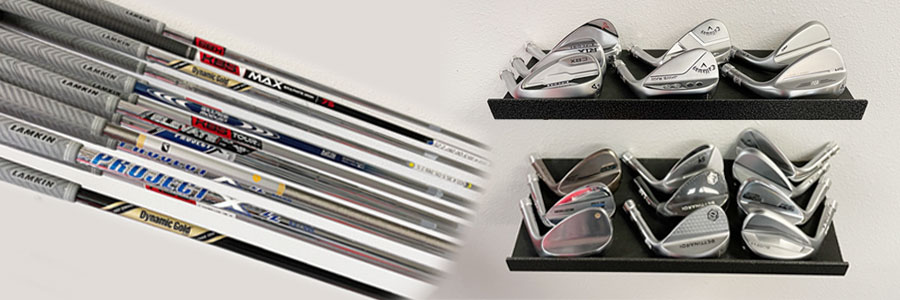
Wedge shafts are critical to ensure you achieve the accuracy, control and consistency you want from your new wedges. If you are thinking about getting new wedges, make sure you have the right shafts. Getting optimal spin rates, distance, proper gapping between wedges and shot dispersion can only be achieved with the right wedge shaft. Here’s why.
- Standard wedge shaft weight and flex doesn’t match irons. jump to details
- Most PGA and LPGA tour players match wedge shafts to irons. jump to details
- Consistent swing feel through lob wedge. jump to details
- New shaft technologies. jump to details
- Wedge fittings are best with Trackman. jump to details
“Your approach to wedge fittings is spot-on. Not only is D’Lance Golf the best place to do a wedge fitting, your wedge fitting and build philosophy and ability to customize is what every golfer needs.”
– Chris Melendez, PGA Instructor and Master Club Fitter, Boulder/Denver, Colorado.
Standard wedge shaft flex
Most importantly, there is no consistency in wedge shaft flex and weight across the major brands. Most wedges you buy off the rack will have a standard medium to heavy steel wedge shaft. For example, True Temper Dynamic Gold shafts are very common. A couple more specific examples:
- Titleist uses an S200 (130 gram) shaft in their SM9 wedges.
- Mizuno uses the DG S400 (136 gram) shaft in the new T22 wedges.
- Callaway, on the lighter side, uses the True Temper Dynamic Gold Spinner (115 gram) shaft in their Jaws Raw wedges.
- Similarly, Cleveland uses the Dynamic Gold Spinner (115 gram) shaft in their RTX Zipcore wedges.
- Ping uses their own proprietary Z115 (115 gram) shaft in their Glide 4.0 and Glide 4.0 Pro wedges.
Only if you are playing a steel shaft in your irons will the weight and flex of these wedge shafts come close to matching you. A couple examples: True Temper Dynamic Gold, KBS Tour, or Nippon Modus 3 120. But, there may be significant flex differences that can impact shot dispersion and consistency.
Playing graphite shafts in your irons and steel shafts in your wedges? There will be some issues in terms of distance and trajectory. However, if you purchase a stock set of clubs with a gap and sand wedge included, you will get the same shaft as what is in the rest of the iron set. This can be a good thing in terms of weight. But, we often see the actual flex is quite a bit softer in the sand and lob wedges due to the heavier weight.
What wedge shafts do tour players use?
So what wedge shafts do the pros use? Check out the WITB (what’s in the bag) for several PGA Tour, LPGA Tour and Champions Tour players. You will see that most tour players play the same shafts in all their wedges as in their irons. Cameron Smith plays the same KBS Tour 130X in his irons and all his wedges. Jessica Korda plays the same True Temper Dynamic Gold 105 S shafts in her irons and wedges. Repeatedly, we have found that having the same shaft in your wedges as irons creates consistent swing weight, feel and accuracy most golfers desire.
Some tour players like Si Woo Kim and In Gee Chun play softer flexes and heavier weights in their sand and lob wedges. Ted Potter Jr. and Steve Stricker also favor that setup. And, Rory McIlroy plays a softer flex shaft in his wedges – Project X 6.5 versus the Project X 7.0 in his irons. Each of these golfers prefer this setup for feel in their attack shots. For lower handicap golfers that want feel, adjusting the shaft flex and playing to a heavier swing weight may work for you.
Using the same flex wedge shaft as irons creates consistency.
The main reason we recommend shaft consistency in irons and wedges is play consistency. For amateur players we can make the flex and performance feel very consistent from pitching wedge through gap wedge, sand wedge and lob wedge. It makes no sense, for example, to be playing a light weight 70 to 80 gram graphite shaft in your irons and a stock, off-the-shelf 130+ gram True Temper S330 or S400 shaft in your gap, sand and lob wedges. The feel and performance simply won’t be the same.
These stock wedge shafts will thus play stiffer. The result could cause a loss of distance and lower ball flight than expected. Worse, you could be giving up landing angle making it hard to “hold the green” with your wedges. If we do make heavier shaft weight recommendations, we make them for the sand and lob wedge for more feel around the green and in the bunker. But, we only go 10 grams heavier.
New wedge shaft flexes
There have been a lot of new offerings in wedge shafts including the True Temper Dynamic Gold 115 wedge shafts (read our review) and the KBS Hi Rev 2.0 wedge shafts. Each offer lighter weight or increased spin and more controlled ball flight. These are great if you need lighter weight to match your iron shafts. Also, this approach works for players that lack the technique to hit those punch spin wedge shots. There are also some new graphite wedge shafts from ACCRA and Fujikura that are in the 115 to 125 gram range.
Why consider a wedge fitting?
When we go through an iron and wedge fitting at our D’Lance Golf Performance Center, we get very specific with our golfers. In addition to wedge shaft flex and length, we also get into the specifics of lofts, lies, bounces and grinds. Each individual has certain swing dynamics that not only dictate the weight and flex of the shaft but the bounces and grinds as well. The same thinking with the type of courses and sand conditions.
Come in for an iron and wedge fitting or just a wedge fitting to experience how the correct wedge shaft, correct shaft flex and correct shaft length can improve your wedge game. The result – more consistency, optimal distance gapping, optimal spin, consistent feel and the high-performance you expect for your short game.
